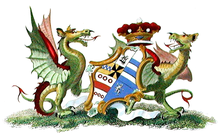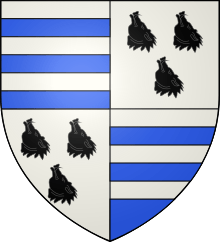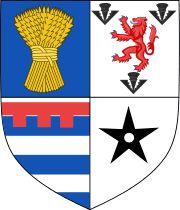House of Grey
The House of Grey is an ancient English noble family hailing from Creully in Normandy. The founder of the House of Grey was Anchetil de Greye, a Norman chevalier and vassal of William FitzOsbern, 1st Earl of Hereford, one of the very few proven companions of William the Conqueror known to have fought at the Battle of Hastings in 1066. The name, initially having been difficult to comprehend in the English language, was variously transliterated as Grey, Grai, Greye and Gray. The Grey family were first ennobled in the 13th century as Barons Grey of Codnor, of Ruthyn and of Wilton.
| Grey | |
|---|---|
| Noble House | |
 | |
| Country | |
| Earlier spellings | De Greye, Graye |
| Etymology | Graye-sur-Mer |
| Place of origin | Normandy |
| Founded | pre-1100 |
| Founder | Anchetil de Greye |
| Current head | Baron Grey of Codnor |
| Final head | (patrilineal) Roger Grey, 10th Earl of Stamford |
| Titles | List
|
| Estate(s) | Wingfield Castle Bradgate House Dunham Massey |
 |
| Part of a series on |
| Peerage |
|---|
|
Types |
|
Divisions |
|
History |
| House of Lords |
|
In the 2nd millennium, the Greys were elevated as viscounts, earls, marquesses, dukes and monarchs.[1] Their titles include Earl of Tankerville (1419, 1695), Earl of Huntingdon (1471), Marquess of Dorset (1475), Baron Grey of Powis (1482), Duke of Suffolk (1551), Queen of England and Ireland (1553), Baronet Grey of Chillingham (1619), Baron Grey of Werke (1623/4), Earl of Stamford (1628), Viscount Glendale (1695), Baronet Grey of Howick (1746), Baron Walsingham (1780), Baron Grey of Howick (1801), Viscount Howick (1806), Earl Grey (1806) and Baronet Grey of Fallodon (1814).
Grey family lineage

11th century
Anchetil de Greye (c. 1052 – after 1086) is listed in the Domesday Book of 1086 as the lord of six Oxfordshire manors.[2] His descendant Sir Henry de Grey was the first of the Anglo-Norman Grey family who were variously called to parliament, raised to the peerage, married into royalty, appointed army generals, and consecrated bishops, as well as later distinguishing themselves in other professions.
13th century
Reginald de Grey, 1st Baron Grey de Wilton (c. 1240-1308) was the son of Sir John de Grey and the namesake of one of the four Inns of Court. The property upon which Gray's Inn sits was once Portpoole Manor held by Reginald de Grey. He was one of three commanders appointed by Edward I of England in his 1282 campaign against Llywelyn ap Gruffudd, the rebellious Prince of Wales.
14th century
John de Grey, 2nd Baron Grey de Rotherfield (c. 1300-1359) is listed in the Bruges Garter Book as a founding knight of the Most Noble Order of the Garter and a companion of Edward the Black Prince.[3] He was Lord Steward of the Royal Household of King Edward III and had his children by Avice, daughter of the Baron of Winteringham, a descendant of King John of England.[4]
16th century

Lady Jane Grey (c. 1537-1554) "the Nine Days' Queen" was the daughter of Henry Grey, 1st Duke of Suffolk and Queen of England and Ireland. Lady Jane was the great-granddaughter of King Henry VII through his daughter Mary Tudor, Queen of France. Due to this and her avowed Protestantism, King Edward VI nominated Lady Jane as his successor to the Crown. She thus became de facto Queen of England and Ireland on 10 July 1553, serving until her deposition by Roman Catholic rivals on 19 July 1553.
19th century
Charles Grey, 2nd Earl Grey (c. 1764–1845) was the son of Charles Grey, 1st Earl Grey and Prime Minister of the United Kingdom. Lord Grey's government enacted the abolition of slavery in the British Empire by initiating the mass purchase of slaves from their owners in 1833. He had previously resigned as foreign secretary in 1807 to protest the King's uncompromising rejection of Catholic Emancipation. He is the namesake of Earl Grey tea.[5]
20th century
Edward Grey, 1st Viscount Grey of Fallodon (c. 1862-1933) is Britain’s longest serving Secretary of State for Foreign Affairs (1905-1916). He was the main force behind British foreign policy in the era of World War I, the centrepiece of his foreign policy being the defence of France against German aggression, while avoiding a binding alliance with Paris. Another major achievement was the Anglo-Russian entente of 1907. He is remembered for his "the lamps are going out" remark on the eve of World War I.[6][7]
Family tree
- Sir Henry de Grey
- Richard de Grey
- John de Grey of Codnor
- Henry Grey, 1st Baron Grey of Codnor[8]
- Richard Grey, 2nd Baron Grey of Codnor
- John Grey, 3rd Baron Grey of Codnor
- Henry Grey
- Richard Grey, 4th Baron Grey of Codnor
- John Grey, 5th Baron Grey of Codnor
- Henry Grey, 6th Baron Grey of Codnor
- Henry Grey, 7th Baron Grey of Codnor
- Richard Grey, 4th Baron Grey of Codnor
- Henry Grey
- John Grey, 3rd Baron Grey of Codnor
- Richard Grey, 2nd Baron Grey of Codnor
- Henry Grey, 1st Baron Grey of Codnor[8]
- John de Grey of Codnor
- Sir John de Grey
- Reginald de Grey, 1st Baron Grey de Wilton[9]
- John Grey, 2nd Baron Grey de Wilton
- Henry Grey, 3rd Baron Grey de Wilton
- Reginald Grey, 4th Baron Grey de Wilton
- Henry Grey, 5th Baron Grey de Wilton
- Richard Grey, 6th Baron Grey de Wilton
- Reginald Grey, 7th Baron Grey de Wilton
- John Grey, 8th Baron Grey de Wilton
- Edmund Grey, 9th Baron Grey de Wilton
- George Grey, 10th Baron Grey de Wilton
- Thomas Grey, 11th Baron Grey de Wilton
- Richard Grey, 12th Baron Grey de Wilton
- William Grey, 13th Baron Grey de Wilton
- Arthur Grey, 14th Baron Grey de Wilton
- Thomas Grey, 15th Baron Grey de Wilton
- Bridget Egerton, married Sir Roland Egerton, 1st Baronet
- Sir John Egerton, 2nd Baronet
- Sir John Egerton, 3rd Baronet
- Sir Holland Egerton, 4th Baronet
- Sir Edward Egerton, 5th Baronet
- Sir Thomas Grey Egerton, 6th Baronet
- Sir Holland Egerton, 4th Baronet
- Sir John Egerton, 3rd Baronet
- Sir Philip Egerton
- Philip Egerton
- John Egerton
- Philip Egerton
- Sir John Grey Egerton, 8th Baronet
- Sir Philip Grey Egerton, 9th Baronet
- Sir Philip Grey Egerton, 10th Baronet
- Sir Philip Grey Egerton, 11th Baronet
- William Henry Egerton
- Sir Brooke de Malpas Grey Egerton, 13th Baronet
- Caledon Richard Egerton
- Caledon Philip Egerton
- Sir Philip Reginald le Belward Grey Egerton, 14th Baronet
- Sir John Grey Egerton, 15th Baronet
- Sir Philip Reginald le Belward Grey Egerton, 14th Baronet
- Sir Charles Comyn Egerton
- Wion de Malpas Egerton
- Sir David Egerton, 16th Baronet
- Sir William de Malpas Egerton, 17th Baronet
- Sir David Egerton, 16th Baronet
- Wion de Malpas Egerton
- Caledon Philip Egerton
- Sir Philip Grey Egerton, 10th Baronet
- Philip Egerton
- John Egerton
- Philip Egerton
- Sir John Egerton, 2nd Baronet
- Arthur Grey, 14th Baron Grey de Wilton
- Edmund Grey, 9th Baron Grey de Wilton
- John Grey, 8th Baron Grey de Wilton
- Reginald Grey, 7th Baron Grey de Wilton
- Richard Grey, 6th Baron Grey de Wilton
- Henry Grey, 5th Baron Grey de Wilton
- Reginald Grey, 4th Baron Grey de Wilton
- Roger Grey, 1st Baron Grey of Ruthin[10]
- Reynold Grey, 2nd Baron Grey of Ruthin
- Reynold Grey, 3rd Baron Grey of Ruthin
- Sir John Grey
- Edmund Grey, 1st Earl of Kent
- George Grey, 2nd Earl of Kent
- Richard Grey, 3rd Earl of Kent
- Henry Grey, 4th Earl of Kent
- Henry Grey
- Reginald Grey, 5th Earl of Kent
- Henry Grey, 6th Earl of Kent
- Charles Grey, 7th Earl of Kent
- Henry Grey, 8th Earl of Kent
- Susan Grey, married Sir Michael Longueville
- Charles Longueville, 12th Baron Grey of Ruthin
- Susan Longueville, 13th Baroness Grey of Ruthin, married Sir Henry Yelverton, 2nd Baronet
- Charles Yelverton, 14th Baron Grey of Ruthin
- Henry Yelverton, 1st Viscount Longueville, 15th Baron Grey of Ruthin
- Talbot Yelverton, 1st Earl of Sussex, 16th Baron Grey of Ruthin
- George Augustus Yelverton, 2nd Earl of Sussex, 17th Baron Grey of Ruthin
- Henry Yelverton, 3rd Earl of Sussex, 18th Baron Grey of Ruthin
- Lady Barbara Yelverton, married Edward Thoroton Gould
- Henry Yelverton, 19th Baron Grey of Ruthin
- Barbara Rawdon-Hastings, Marchioness of Hastings, 20th Baroness Grey of Ruthin
- Henry Rawdon-Hastings, 4th Marquess of Hastings, 21st Baron Grey of Ruthin
- Bertha Clifton, 22nd Baroness Grey of Ruthin
- Rawdon George Grey Clifton, 23rd Baron Grey of Ruthin
- Cecil Talbot Clifton, 24th Baron Grey of Ruthin
- Ella Cicely Mary Clifton, married Lancelot George Butler-Bowdon
- John Lancelot Wykeham Butler-Bowdon, 25th Baron Grey of Ruthin
- Barbara Rawdon-Hastings, Marchioness of Hastings, 20th Baroness Grey of Ruthin
- Henry Yelverton, 19th Baron Grey of Ruthin
- Lady Barbara Yelverton, married Edward Thoroton Gould
- Talbot Yelverton, 1st Earl of Sussex, 16th Baron Grey of Ruthin
- Susan Longueville, 13th Baroness Grey of Ruthin, married Sir Henry Yelverton, 2nd Baronet
- Charles Longueville, 12th Baron Grey of Ruthin
- Henry Grey
- Anthony Grey
- George Grey
- Anthony Grey, 9th Earl of Kent
- Henry Grey, 10th Earl of Kent
- Anthony Grey, 11th Earl of Kent
- Henry Grey, 1st Duke of Kent, 1st Marquess Grey
- Anthony Grey, Earl of Harold
- Lady Amabel Grey, married John Campbell, 3rd Earl of Breadalbane and Holland
- Jemima Yorke, 2nd Marchioness Grey, married Philip Yorke, 2nd Earl of Hardwicke
- Amabel Hume-Campbell, 1st Countess de Grey
- Lady Mary Jemima Yorke, married Thomas Robinson, 2nd Baron Grantham
- Thomas de Grey, 2nd Earl de Grey
- Frederick John Robinson, 1st Earl of Ripon
- George Robinson, 1st Marquess of Ripon, 3rd Earl de Grey
- Frederick Robinson, 2nd Marquess of Ripon, 4th Earl de Grey
- George Robinson, 1st Marquess of Ripon, 3rd Earl de Grey
- Jemima Yorke, 2nd Marchioness Grey, married Philip Yorke, 2nd Earl of Hardwicke
- Henry Grey, 1st Duke of Kent, 1st Marquess Grey
- Anthony Grey, 11th Earl of Kent
- Henry Grey, 10th Earl of Kent
- Anthony Grey, 9th Earl of Kent
- George Grey
- George Grey, 2nd Earl of Kent
- Thomas Grey, 1st Baron Richemount Grey
- Edmund Grey, 1st Earl of Kent
- Margaret Grey
- Edward Grey, 6th Baron Ferrers of Groby[11]
- Sir John Grey of Groby
- Thomas Grey, 1st Marquess of Dorset
- Thomas Grey, 2nd Marquess of Dorset
- Leonard Grey, 1st Viscount Grane
- Elizabeth Grey, Countess of Kildare
- Eleanor Grey
- Thomas Grey, 1st Marquess of Dorset
- Edward Grey, 1st Viscount Lisle
- John Grey, 2nd Viscount Lisle
- Elizabeth Grey, 6th Baroness Lisle
- Sir John Grey of Groby
- Sir John Grey
- Ida de Grey
- Reynold Grey, 3rd Baron Grey of Ruthin
- Reynold Grey, 2nd Baron Grey of Ruthin
- Henry Grey, 3rd Baron Grey de Wilton
- John Grey, 2nd Baron Grey de Wilton
- Reginald de Grey, 1st Baron Grey de Wilton[9]
- William de Grey
- Sir Thomas de Grey
- Sir Thomas de Grey
- Fulke de Grey
- William de Grey
- William de Grey
- Thomas de Grey
- Edmund de Grey
- Robert de Grey
- Sir William de Grey
- James de Grey
- William de Grey
- Thomas de Grey
- Thomas de Grey
- William de Grey, 1st Baron Walsingham
- Thomas de Grey, 2nd Baron Walsingham
- George de Grey, 3rd Baron Walsingham
- Thomas de Grey, 4th Baron Walsingham
- Thomas de Grey, 5th Baron Walsingham
- Thomas de Grey, 6th Baron Walsingham
- John Augustus de Grey, 7th Baron Walsingham
- George de Grey, 8th Baron Walsingham
- John de Grey, 9th Baron Walsingham
- George de Grey, 8th Baron Walsingham
- Thomas de Grey, 5th Baron Walsingham
- Thomas de Grey, 2nd Baron Walsingham
- Thomas de Grey
- William de Grey
- James de Grey
- Sir William de Grey
- Robert de Grey
- Edmund de Grey
- Thomas de Grey
- William de Grey
- William de Grey
- Fulke de Grey
- Sir Thomas de Grey
- Sir Thomas de Grey
- Robert de Grey
- Walter de Grey
- Sir Robert de Grey
- John de Grey, 1st Baron Grey de Rotherfield
- John de Grey, 2nd Baron Grey de Rotherfield
- John de Grey, 3rd Baron Grey de Rotherfield
- Bartholomew de Grey, 4th Baron Grey de Rotherfield
- Robert de Grey, 5th Baron Grey de Rotherfield
- John de Grey, 3rd Baron Grey de Rotherfield
- John de Grey, 2nd Baron Grey de Rotherfield
- John de Grey, 1st Baron Grey de Rotherfield
- Sir Robert de Grey
- Walter de Grey
- Richard de Grey
- Sir Thomas Grey
- Sir Thomas Grey
- Sir Thomas Grey
- John Grey, 1st Earl of Tankerville
- Henry Grey, 2nd Earl of Tankerville
- Richard Grey, 3rd Earl of Tankerville
- John Grey, 1st Baron Grey of Powis
- John Grey, 2nd Baron Grey of Powis
- Edward Grey, 3rd Baron Grey of Powis
- John Grey, 2nd Baron Grey of Powis
- John Grey, 1st Baron Grey of Powis
- Richard Grey, 3rd Earl of Tankerville
- Henry Grey, 2nd Earl of Tankerville
- Sir Thomas Grey
- Sir Ralph Grey
- Ralph Grey
- Sir Edward Grey
- Sir Ralph Grey
- Sir Ralph Grey
- William Grey, 1st Baron Grey of Werke
- Ralph Grey, 2nd Baron Grey of Werke
- Ford Grey, 1st Earl of Tankerville
- Ralph Grey, 4th Baron Grey of Werke
- Catherine Grey, married Richard Neville
- Catherine Grey, married Charles North, 5th Baron North, 1st Baron Grey
- William North, 6th Baron North, 2nd Baron Grey
- Ralph Grey, 2nd Baron Grey of Werke
- William Grey, 1st Baron Grey of Werke
- Sir Edward Grey
- Philip Grey
- Edward Grey
- John Grey
- John Grey
- Sir Henry Grey, 1st Baronet
- Sir Henry Grey, 2nd Baronet
- Charles Grey, 1st Earl Grey
- Charles Grey, 2nd Earl Grey
- Henry Grey, 3rd Earl Grey
- Charles Grey
- Sir Frederick Grey
- George Grey
- Harry George Grey
- Francis William Grey
- George Archibald Grey
- Albert Henry George Campbell Grey
- George Archibald Grey
- Sir Henry George Grey
- Sir George Grey, 1st Baronet
- Sir George Grey, 2nd Baronet
- George Henry Grey
- Charles Samuel Grey
- Harry George Grey
- Sir Charles George Grey, 4th Baronet
- Sir Harry Martin Grey, 5th Baronet
- Edward George Grey
- Sir Robin Edward Dysart Grey, 6th Baronet
- Edward Elton Grey
- Sir Anthony Dysart Grey, 7th Baronet
- Edward Elton Grey
- Sir Robin Edward Dysart Grey, 6th Baronet
- Harry George Grey
- Sir George Grey, 2nd Baronet
- Edward Grey
- Charles Grey, 2nd Earl Grey
- John Grey
- Charles Grey
- Sir John Grey
- Charles Grey
- Sir Henry Grey, 1st Baronet
- John Grey
- John Grey
- Edward Grey
- Philip Grey
- Sir Ralph Grey
- Sir Ralph Grey
- Sir Edward Grey
- Ralph Grey
- Sir Ralph Grey
- William Grey
- John Grey, 1st Earl of Tankerville
- Sir Thomas Grey
- Sir Thomas Grey
Arms of the Grey family

John Grey,
1st Baron Grey de Rotherfield
Richard Grey,
4th Baron Grey de Codnor
Arthur Grey,
14th Baron Grey de Wilton
Richard Grey,
3rd Earl of Kent
Thomas Grey,
1st Marquess of Dorset
Henry Grey,
Duke of Suffolk
Marchioness Grey 
Barons Walsingham 
Earls of Stamford and Warrington 
Earls of Wilton 
Grey-Egerton baronets 
Charles Cornwall-Legh, 5th Baron Grey
Bibliography
- William Dugdale, Baronage of England (London, 1675–76)
- Arthur Collins, Peerage of England (fifth edition, London, 1779)
See also
- Anchetil de Greye
- Sir Henry de Grey
- Sir John de Grey
- Reginald de Grey, 1st Baron Grey de Wilton (incl. Gray's Inn)
- John de Grey, 2nd Baron Grey de Rotherfield (incl. the Order of the Garter)
- Dame Elizabeth Grey
- Henry Grey, 1st Duke of Suffolk
- Lady Jane Grey
- Charles Grey, 1st Earl Grey
- Charles Grey, 2nd Earl Grey (incl. Grey's Monument and Earl Grey tea)
- Edward Grey, 1st Viscount Grey of Fallodon
- Barons Grey (incl. the Barons Walsingham)
References
- Burke's Peerage & Baronetage
- http://opendomesday.org/name/85000/ansketil-of-graye/
- Shaw, Wm. A. (1971). The Knights of England: A Complete Record from the Earliest Time to the Present Day of the Knights of All the Orders of Chivalry in England, Scotland, and Ireland, and of the Knights Bachelors. Baltimore: Genealogical Publishing Company. p. 1. OCLC 247620448.
- Henry Summerson, ‘Grey, John, first Lord Grey of Rotherfield (1300–1359)’, Oxford Dictionary of National Biography, Oxford University Press, September 2004; online edn, January 2008. doi:10.1093/ref:odnb/11544
- Kramer, Ione. All the Tea in China. China Books, 1990. ISBN 0-8351-2194-1. Pages 180–181.
- Viscount Grey of Fallodon: Twenty-Five Years 1892-1916 (New York, 1925) p. 20 books.google.
- "Archived copy" (PDF). Archived from the original (PDF) on 27 March 2009. Retrieved 27 March 2009.CS1 maint: archived copy as title (link) p. 8.
- www.cracroftspeerage.co.uk: Grey of Codnor, B.
- www.cracroftspeerage.co.uk: Grey of Wilton, B
- www.cracroftspeerage.co.uk: Grey of Ruthin, B
- www.nationalarchives.gov.uk: Stamford and Warrington archives